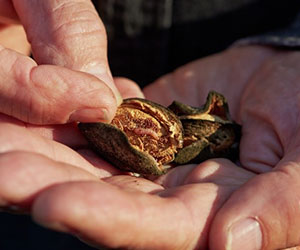June 28, 2019 — Few pests are as threatening to almonds as navel orangeworm (NOW), which damages nuts and spurs growth of a fungus that causes aflatoxin, Aspergillus flavus and A. parasiticus. Together, these threats reduce yield and grower returns, and ultimately can lead to rejected shipments — a damaging outcome for growers, handlers and customers. In fact, according to Josette Lewis, director of Agricultural Affairs at the Almond Board of California, “The industry spends approximately $5,250,000 on pre-export sampling to reduce the risk and cost of rejections due to aflatoxin. Still, last year alone, rejected shipments cost the industry an additional $270,000.”
 Navel orangeworm (NOW) creates wounds favoring the growth of the fungus Aspergillus flavus, thus leading to aflatoxin contamination. A new biocontrol option, AF36, reduces levels of the harmful toxigenic strains of Aspergillus in orchards, leading to lower levels of aflatoxin.
Navel orangeworm (NOW) creates wounds favoring the growth of the fungus Aspergillus flavus, thus leading to aflatoxin contamination. A new biocontrol option, AF36, reduces levels of the harmful toxigenic strains of Aspergillus in orchards, leading to lower levels of aflatoxin.
Fortunately, the combined threat of NOW and Aspergillus fungus can be managed. NOW control, especially removal and destruction of “mummy” nuts that provide safe harbor to overwintering worms, is a critical step. Other essential controls include monitoring flights of NOW throughout the season to determine if spraying is needed and utilizing mating disruption, a technology that’s increased in popularity within the industry over the past few years.
In 2018, a new tool became available for almonds that directly targets the Aspergillus fungus itself. Known as AF36, this new control option contains a harmless strain of Aspergillus that is introduced to orchards on sterilized sorghum seed. When irrigated, the fungus produces and releases spores that compete with and largely displace the toxic forms of Aspergillus. This reduces levels of “bad” Aspergillus in the soil and in harvested crops, leading to lower levels of aflatoxin.
“We want to promote an increase in use of AF36,” said Themis Michailides, a plant pathologist based at the University of California Kearney Agricultural Research & Extension Center in Parlier. “In 2018, just a few almond growers used it and we think it has significant potential.”
AF36 has been registered for use in other crops. For instance, it’s been registered in pistachios since 2012 and about 200,000 acres of pistachios were treated both in 2017 and 2018.
AF36 — What do we know?
Michailides was a featured speaker at the Almond Quality and Food Safety Symposium in Modesto on June 13, where he gave a presentation titled “Aflatoxin Understanding and Control: All the Tools in the Shed.”
Currently, the only AF36 product registered for use in almonds is known as Prevail (available through Western Milling in California). The product should be applied yearly at 10 pounds per acre, with ideal application timing about two weeks before hull split to allow for maximum sporulation.
Michailides noted that the product should be applied only to the areas that are reached by the irrigation system, as opposed to the areas between rows of trees, because the product is activated by moisture from irrigation. Irrigation should commence immediately after application.
Research suggests the product is more effective when used year after year, as it helps build up the population of the AF36 strain in the soil. Michailides said it is likely the effect would diminish over time if applications stopped.
Michailides also suggested the slow adoption of the product in its first year could be because of lack of familiarity with the product among growers, growers not having proper application equipment or a shortage of AF36 Prevail that was available last year. Cost does not appear to be a major factor.
Potential Options Beyond AF36
Although Prevail is the only AF36 product currently registered, another AF36 formulation could soon be available. According to Michailides, Afla-Guard GR, created by Syngenta, uses barley instead of sorghum as the sterile seed carrier for the fungus and appears to sporulate better under drier and cooler conditions. Syngenta already has registered the product for use in peanuts and corn and is now looking to register the product in California for use on almonds, figs and pistachios.
Meanwhile, Michailides is continuing several research projects, partially funded by the Almond Board, to further establish the efficacy of AF36 and compare that to earlier trials that used a different formulation and seed carrier. One ongoing trial includes 100-acre treatments in five different orchards to compare control plots to treated areas. The research includes soil sampling for fungus levels as well as checking for infection in harvested almonds.
While Michailides recommends almond growers give this aflatoxin control method a try, he said it should be added to — not substitute for — proactive, year-round, integrated pest management for NOW control, and he drives home the importance of the destruction of mummy nuts: “The first tool is still winter sanitation of the mummies and prevention of NOW damage.”
ABC continues to research best practices to control navel orangeworm in almond orchards and recently committed $1 million dollars to fund a Navel Orangeworm Sterile Insect Technique research project. For more information on how to control NOW in your orchards, visit Almonds.com/Pests and the Kearney Agricultural Research Center’s on biocontrol of aflatoxins.